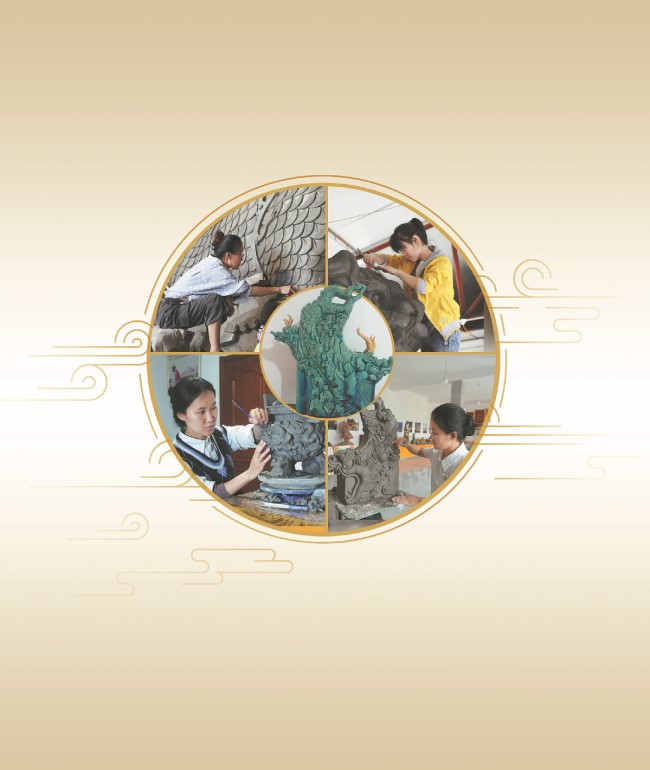Liu Wenting, a devoted craftswoman from Jiexiu, Shanxi, preserves her family's colored glaze legacy, blending ancient traditions with modern education to inspire a new generation of artisans.

Liu Wenting spends her days in creating colored glaze artworks. [Photo/China Daily]
In the heart of Jiexiu, North China's Shanxi province, Liu Wenting, a woman in her 30s, embraces her destiny as a colored glaze craftswoman, following in the footsteps of her family.
Raised in the rich tradition of this ancient art, Liu is now a recognized inheritor of Jiexiu's intangible cultural heritage, as acknowledged by local authorities.
Liu's affinity for the age-old craft dates back to her earliest memories of playing with clay — the raw material fundamental to this traditional art. After completing her college education, Liu began a career in the family trade, having acquired skills passed down from her father and three uncles.
Jiexiu, hailed as the "hometown of colored glaze" in China, is one of the birthplaces of colored glaze for traditional Chinese architecture.
The colored glaze pieces include ceramics, building models, and sculptures. Renowned for their vibrant hues and distinctive designs, these pieces have found frequent application in the decoration of ancient Chinese palaces, temples, and pagodas.
Glazes can also form a variety of surface finishes, such as different colors and gloss levels, influenced not only by raw materials but also by factors like firing temperature, duration, and cooling method. Glazes improve the underlying texture or design, whether it be painted, carved, or engraved.
Since the true form of earthenware only reveals itself after cooling from the kiln's heat, this unpredictable nature adds to the intricacy and allure of the craft.
According to Liu, the disposition, color, and texture of a piece can change significantly due to even a slight alteration in how it's made. This means that the procedures required to create handmade colored glaze cannot be easily automated so it's hard to put traditional craftsmen out of business.
Sometimes even skilled artisans like Liu Kaibao, Liu Wenting's father and a fifth-generation craftsman in Liu's family, cannot guarantee consistent outcomes, especially with particular shades like peacock blue.
Liu Kaibao, who lives in Hongshan village, is one of the first intangible cultural heritage inheritors of colored glaze in the village. His cousin Li Jianguo, who was previously a technician at the former Hongshan Ceramics Factory, is also a master of the craft.
The Liu family and their relatives, including the Li family, work together in a workshop they jointly founded in the village where they not only design and make colored glaze but also teach the skills and knowledge to their disciples.
"To make colored glaze, you must have clean raw materials and clean water sources, just like you must have a pure heart to make fine products," said Liu Kaibao. "My father's persistence and love for the art and its special beauty had made me fall in love with this craft since I was a child. I have been treating this art as the heritage of my ancestors. I'm obliged to pass it on to future generations."
Over the past two years, Liu Wenting worked with her family to create a giant colored glaze work titled Kylin and Eight Treasures, featuring an auspicious mythical creature from an ancient Chinese legend. This piece was installed in the theater building in the square of Jiexiu Culture and Art Center. The work showcases the Liu family's brilliant technique, and they have been proud of it.
In recent years, the Jiexiu municipal government has placed greater importance on the protection of glaze production techniques. As part of the city's public cultural activities, the Liu family exhibited their works at the vocational school in Jiexiu and introduced the craft to the students in 2021 — the same year they started cooperating with the school, and set up a colored glaze society for students. Since then, the project has attracted over 115 students.
Liu Wenting works as a part-time instructor for the project.
The Liu family workshop also offers students internships so they can gain hands-on experience by taking part in all procedures related to the design and making of colored glaze products.
Last year, the colored glaze works made by the students were exhibited at the third Shanxi Intangible Cultural Heritage Expo in Pingyao, Shanxi.
"This set of 12 zodiac clay sculptures covered by colored glaze is handmade through my imagination. I carefully observed my teacher Liu Wenting's demonstrations. Coupled with my exploration and innovation, I realized that I can make good works as well," said Gao Caixuan, a student whose works were shown at the expo.
"I'm glad to see the ancient crafts appeal to a younger generation," said Liu Wenting. "The cooperation between us and the vocational school creates a new method to pass on traditional skills."
According to her, previously, such skills were only passed down within families. But now, a new generation can acquire these skills and pass them on in their own way.
liyang@chinadaily.com.cn



